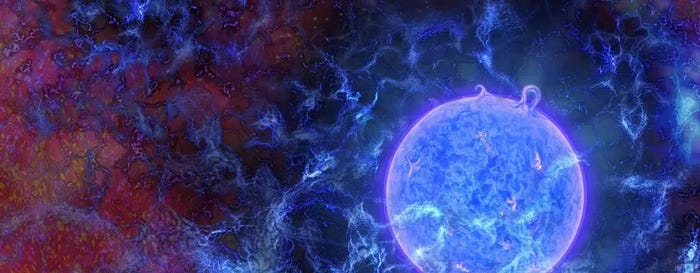
How massive can a star be? The limit depends on the available mass. A single star can be as massive as a galaxy. To feed such a beast, a giant cloud of gas needs to collapse without fragmenting into smaller components in the process. In a paper published 30 years ago, I proposed in collaboration with Fred Rasio that such a collapse of primordial gas clouds could have seeded the formation of the first supermassive black holes. These are currently observed as quasars up to a redshift of 10, merely 500 million years after the Big Bang.
A star with more than a thousand solar masses is expected to exhaust its nuclear fuel over a few million years and likely collapse to a black hole. It shines close to the limiting brightness, the so-called Eddington luminosity — named after the British astronomer Arthur Eddington who derived it, at which radiation pressure balances gravity. Material on the surface of a supermassive star hovers at nearly zero effective gravity and can easily escape in a powerful wind.
In a subsequent paper with Volker Bromm and Rolf Kudritzki, we showed that the surface temperature of supermassive stars is around a hundred thousand degrees, independent of their mass. This implies that their luminosity scales roughly with their surface area. To balance gravity, the luminosity also scales linearly with the mass of the supermassive star. A decade after my paper with Fred, I published a follow-up paper with Volker who was my postdoc at that time, suggesting a direct path towards making black hole seeds through the collapse of primordial gas clouds made of hydrogen atoms. Such clouds might not fragment into normal stars because they were not enriched yet with heavy elements, and molecular hydrogen could be dissociated in them by background ultraviolet radiation. By now, this idea had become popular in the recent astrophysics literature and the process is labeled “Direct Collapse Black Holes (DCBH).”
Without rotation, supermassive stars are unstable to gravitational collapse as a result of instabilities triggered by General Relativistic corrections to their energy. The addition of spin stabilizes them and could lead to the formation of a flattened disk as an intermediate step before they end up as a black hole.
Normal massive stars below a hundred solar masses could also seed a quasar. In galactic nuclei which were already enriched with heavy elements, there would be many black hole seeds of stellar mass. This is a classic setup for competitive growth. One lucky seed, situated close to the galactic center where the gas density peaks, will grow exponentially and win the competition by developing the largest event horizon. The beast with the largest mouth will eat the most and grow the fastest to even bigger proportions. Because of the smallness of the initial seed, this scenario takes more time than that required for Direct Collapse Black Holes, which start with a supermassive seed. Since time is short at redshift 10, supermassive stars might be required to explain the early formation of quasars in the infant universe.
Recent data from the Webb telescope on the galaxy around a quasar J1120+0641 at a redshift of 7.08, or equivalently 750 million years after the Big Bang, suggested that its black hole mass is 54% of the stellar mass around it. The existence of overmassive black holes of this type favors a massive seed origin for the black hole, where a giant gas cloud collapsed with mild fragmentation into normal stars. Such a path would feature, at an earlier time, a transient supermassive star. Currently, this black hole is 1.4 billion times more massive than the Sun. The quasar outshines its host galaxy by a factor of a hundred because of its high efficiency for converting rest-mass to radiation compared to nuclear reactions.
The existence of overmassive babies in the delivery room of the early universe is tantalizing. But their subsequent growth was underwhelming relative to star formation around them. This might reflect the ratio between the exponential growth time of black holes and the age of the Universe. When the Universe was young, the black holes radiated much of the time and suppresses the formation of stars around them. However, at late times there are long episodes when the central black hole is dormant, during which star formation thrives. In a recent paper that I published with my brilliant postdoc, Fabio Pacucci, we showed that this rationale could explain the steady increase in total mass of stars relative to that of central black hole with cosmic time. In the present-day universe, supermassive black holes make about a tenth of a percent of the mass of the spheroid of stars that surrounds them.
Another explanation for the different characteristics of early galaxies is that they started with no heavy elements and hence produced supermassive stars. Recent surveys by the Webb telescope identified galaxies with chemical abundances that conventional stellar models fail to replicate, suggesting supermassive stars as the possible source of these distinctive abundance ratios in the early Universe. In collaboration with Devesh Nandal, I am hoping to study in the future the expected telltale signatures of supermassive stars with proper accounting for their rotation, magnetic fields and winds.
Another surprising discovery of the Webb telescope involves an early population of compact red galaxies. The galaxies are redder than expected from their cosmological redshift, indicating additional reddening by a veil of dust. Some of them contain as much mass in evolved stars as our own Milky-Way galaxy. Nevertheless, they are a hundred times smaller in radius, of order a few hundred light years. These tiny red rubies in the sky are commonly dubbed `little red dots.’ They could potentially host embryos of supermassive stars on their path to making quasar seeds. In that case, we might be seeing quasar births in the delivery room of the early universe.
ABOUT THE AUTHOR

Avi Loeb is the head of the Galileo Project, founding director of Harvard University’s — Black Hole Initiative, director of the Institute for Theory and Computation at the Harvard-Smithsonian Center for Astrophysics, and the former chair of the astronomy department at Harvard University (2011–2020). He is a former member of the President’s Council of Advisors on Science and Technology and a former chair of the Board on Physics and Astronomy of the National Academies. He is the bestselling author of “Extraterrestrial: The First Sign of Intelligent Life Beyond Earth” and a co-author of the textbook “Life in the Cosmos”, both published in 2021. The paperback edition of his new book, titled “Interstellar”, was published in August 2024.
